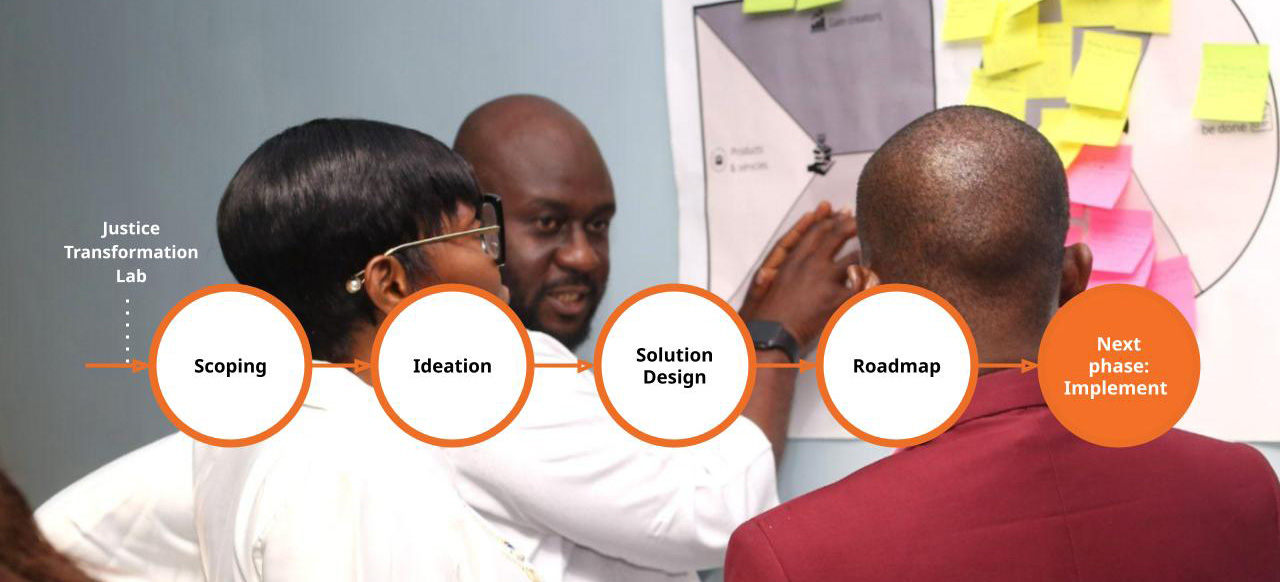
In this Q&A we sat down with Zainab Malik, the Programme Manager for the Justice Innovation Labs (JIL) at HiiL, to understand the purpose of JILs, how they came about, and how they reframe issues when addressing and resolving people’s most pressing justice needs.
What is a Justice Innovation Lab and how did it come to be?
We know that justice problems that people face – be it land, family, crime, or neighbour disputes – are common and have a serious impact on people’s lives. However, more than two-thirds of the world’s population still fail to find any resolution for their problems. It’s obvious that justice systems and the services they provide are simply not meeting the needs of people in their daily lives. This is where people-centred justice comes in, and an aspect of that integrated approach includes Justice Innovation Labs (JILs).
Justice Innovation Labs aim to develop innovative and sustainable solutions that scale people-centred justice services. The JILs convene a diverse group of key justice stakeholders. This includes government leaders, judges, lawyers, community organisers, business owners, and entrepreneurs. Each JIL runs for four to six months and follows a structured design thinking process where the participants scope out the justice problem(s), brainstorm solutions, test ideas, build a sustainable financial model, create a plan of action, and ultimately decide the terms of a pilot programme.
| What is people-centred justice? |
| People-centred justice is an emerging approach that puts people and their justice needs at the centre. This integrated way of working has five components: starting with the collection of data on the needs of people, moving to evidence-based practice by applying what works, combining these best practices into scalable sustainable, game-changing services, creating an enabling environment for that, and forming a movement to make this change happen. Together they keep the focus on system change to ensure justice for better societies. |
What’s the unique value of conducting a JIL?
Innovation Labs have existed for some time now in different sectors such as financial services, health and education. However, making this work for justice requires a different approach. Only processes that are truly people-centred lead to people-centred solutions. In that spirit, JILs bring together people from across the justice sector ecosystem. This includes not only formal justice actors such as police, lawyers, and judges but also informal justice providers and users of justice – those facing or who have faced a justice problem.
This gathering of stakeholders, combined with a dedication and shared responsibility to improve people’s lives, creates an environment for designing new approaches to justice delivery. JILs provide a structure for contributing to people-centred justice so ideas can develop and scale into financially sustainable real-world change.

Where is HiiL implementing our Justice Innovation Labs?
We have conducted Justice Innovation Labs around the world. This includes improving access to community justice in Uganda and Nigeria, and JILs focused on improving access to legal services in Djerba, Tunisia. We have also conducted JILs focused on improving the resolution of neighbour disputes in the Netherlands.
Currently, we are running active JILs on domestic violence in Ogun State, Nigeria, employment justice in Tunisia, land justice in Niger, and community justice in Ethiopia.
Can you share any key learnings?
At the end of the day, justice falls under the monopoly of the state. It’s right there in the social contract. Developing apps and legal delivery models will only take us so far. So, if we truly want to deliver people-centred justice, then real innovation begins with creating (and nurturing) what we call an ‘enabling environment’. This includes making sure that the people-centred solution fits into legal and regulatory frameworks, policy planning and budgets.
Additionally, in order to be truly effective people-centred justice innovations cannot exist on the fringes of the justice chain; they must be at the centre of how justice institutions and actors provide justice to people. For example, community-based justice services that link formal and informal processes have shown successful outcomes in many contexts. However, in order to be truly sustainable their decisions must be recognised by courts.
In our modern world, technology is almost considered synonymous with innovation. But I would caution that the “app-ification” of justice is a dangerous trend. As much as technology has the potential to bring about increased access, it is also a marker of inequality, especially in contexts marked with social and economic inequalities.
For example, internet penetration in Uganda stands at 10%. Less than half the population has a mobile phone connection out of which 71% hold a feature phone. During the JIL on community justice in Uganda, stakeholders initially came up with an online information platform providing users with tailored and evidence-based advice on how to resolve their everyday legal problems. However, during prototyping, it was realised that in order for it to become an accessible service the platform would need to be provided in a variety of non-digital delivery models. Doing so resulted in the set up of kiosks where community workers could support users in how to navigate and use the online tool.
For the JIL in Tunisia, the stakeholders designed a network of community workers and apprentice lawyers that used online and offline tools to provide high-quality legal services directly to the doorsteps of people in Djerba Governorate.
“I have been committed to making sure that the law and its mechanisms work to provide redress to the most vulnerable and marginalised groups.”
As a justice advocate yourself, what advice do you have for current and future justice practitioners?
In simple terms, I think we need to rethink, even forget in some instances, what we know about justice. Let’s test and retest our notions, and adapt our approaches to how justice is made accessible and how justice is delivered. At the end of the day, it’s about what people need. So, if we keep people and their needs in mind, then we’re on the right path to delivering outcomes that improve lives. That’s the essence of Justice Innovation Labs specifically and people-centred justice more broadly.
Further Reading
- Justice Research at HiiL
- Another strong and unequivocal commitment to close the access to justice gap

